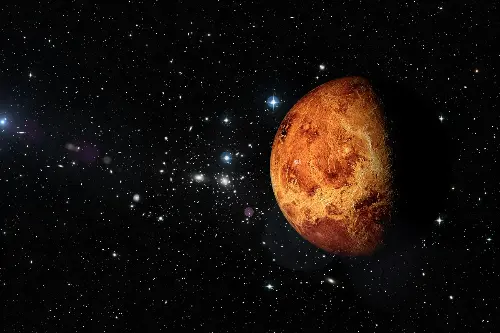Venus, often heralded as Earth's sister planet, might share a similar size and proximity to the Sun, yet this celestial body harbours a plethora of enigmas and extremes that set it apart as a unique world in our solar system. Cloaked in thick clouds and a deceptive, almost serene beauty when observed from a distance, Venus reveals a countenance that is anything but calm upon closer inspection. Let us embark on a journey through the swirling clouds and unveil the remarkable characteristics of this intriguing planet.

Unusual Rotation
One of the most striking peculiarities of Venus is its unusual rotation. Unlike most planets in our solar system, which rotate anticlockwise when viewed from above their north pole, Venus spins clockwise in what is known as a retrograde rotation. This means that on Venus, the Sun would appear to rise in the west and set in the east—quite the opposite of Earth's solar dance. What's more, the length of a day on Venus surpasses that of its year. Venus completes a rotation on its axis in 243 Earth days, while it takes approximately 225 Earth days to orbit the Sun. This means you could celebrate two birthdays on Venus for every single day!
Extreme Surface Conditions
The surface pressure and temperature on Venus are astonishing compared to Earth's. Venus boasts a surface pressure that is 92 times greater than Earth's—equivalent to the pressure one would experience nearly 1 km underwater on Earth. Additionally, temperatures on Venus reach a torrid average of 467 degrees Celsius, making it the hottest planet in our solar system, even surpassing the intensity of Mercury, which is closer to the Sun. This scorching climate is mainly due to the dense atmosphere of carbon dioxide and the intense greenhouse effect it creates.
Atmospheric Wonders
Speaking of the atmosphere, Venus is enshrouded in sulphuric acid clouds that reflect sunlight, rendering the planet incredibly bright in our sky. These clouds perpetually cover the planet, obstructing our view of the surface from space. Sonic thunder is what you might hear as lightning bolts crackle within these clouds. However, rain on Venus doesn't reach the surface as it evaporates due to the extreme heat, creating a metallic dryness in the air.
Volcanic Activity
The surface of Venus is a mirror of its tumultuous atmosphere. The planet is young, geologically speaking, with much of its terrain no more than 500 million years old, suggesting a history of significant volcanic activity. This leads us to the volcanic plains that make up a majority of the planet's surface, indicating that Venus is still geologically active. Magellan spacecraft data from the 1990s indicated that Venus has over 1,600 major volcanoes, though none are confirmed to be erupting at present. But the evidence of lava flows and sulphur compounds in the atmosphere hints at ongoing volcanic activity.
Mountain Ranges and Water Traces
Another fascinating feature of Venus's rugged terrain is the presence of unusual mountain ranges such as Maxwell Montes, the highest peak on the planet, which soars 11 kilometres above the surrounding landscape. These mountains are made of a substance that resembles limestone, suggesting that Venus once housed liquid water.
Super-Rotation Phenomenon
In further defiance of Earthly norms, Venus showcases a strange phenomenon known as "super-rotation." The planet's atmosphere spins much faster than the planet itself—a windy world where upper-level winds reach speeds of up to 360 kilometres per hour, encircling the entire planet in just four Earth days. This atmospheric superrotation contributes to the long-term climate patterns and distribution of heat across the planet.
Weak Magnetosphere
The peculiarities of Venus extend beyond its fiery surface and roiling skies. It also has a weak magnetosphere generated by the interaction of the solar wind with the planet's atmosphere rather than from a molten metallic core like Earth's. This suggests that Venus does not possess the kind of geodynamo-generated field that shields Earth from cosmic radiation—yet another factor that makes Venus far less hospitable to life as we know it.
Unveiling these extraordinary characteristics of Venus only deepens the intrigue and importance of further explorations. Understanding why Venus evolved so differently from Earth, notwithstanding their similarities, could provide valuable insights into the nature of planetary systems as a whole, including those beyond our solar system. As space agencies around the world prepare to once again send probes to our neighbouring planet, Venus is set to feature as a prominent figure in the continued quest to understand the forces that shape the cosmos and perhaps even the origins of life itself.
With its deceptive beauty and turbulent conditions, Venus stands as a reminder of the volatile and dynamic processes that occur on planetary scales. Each discovery peels back another layer in the complex tapestry of our solar system, revealing that even familiar neighbours like Venus are worlds of mystery waiting to be explored. As we continue to gaze upwards and pursue the secrets of the universe, the story of Venus is a testament to both the challenges and the endless possibilities that await us in the great celestial beyond.
